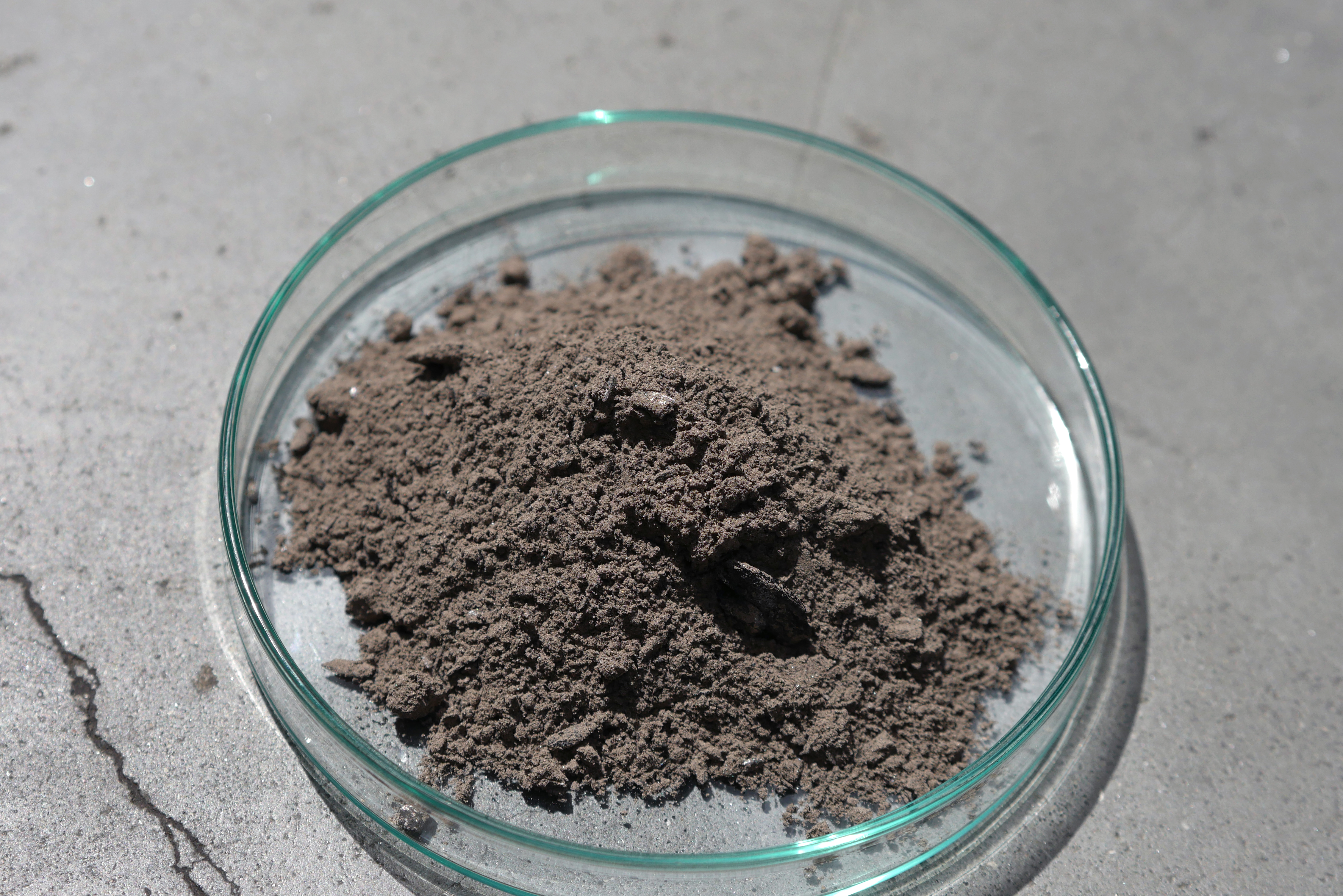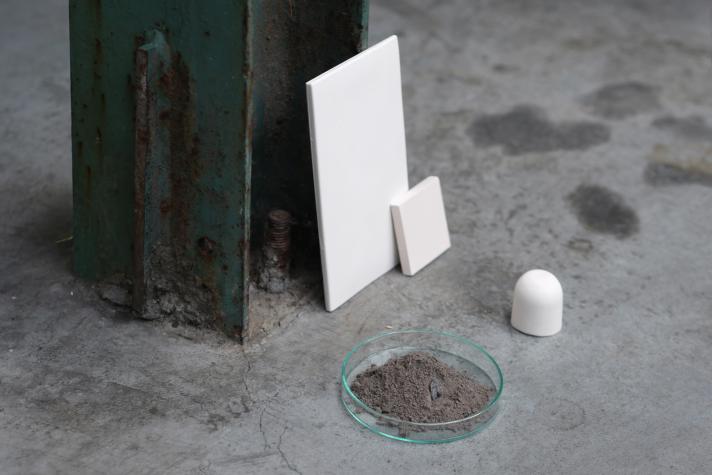
Biofuel Waste is Bliss project redefines the use of ashes from bioenergy waste streams and creates new circular materials and architectural products, such as tiles and bricks. Ashes are sourced from the Vilnius Heat Plant where forestry residues are converted into bioenergy. Within a month they generate around 460 tonnes of wood ash waste, which is costly to dispose of.
Globally, more than 476 million tonnes of ashes are generated from biobased energy production and most of it is landfilled. Ceramic glazes and clay bodies could consist of up to 55% in ash, replacing newly excavated materials.
The idea:
The birth of the project
As a material developer and product designer who uses waste as the main material source, Agne Kucerenkaite is always searching for unexpected potential industrial residue. CO2 extraction and green energy are hot topics today; therefore Agne was discussing the subject with a longtime colleague Marija Spokaite. Since Marija works in the field of environmental science and is a novice ceramist, they would occasionally exchange opinions, ideas and tips. Marija shared that there is a problem circulating in the scientific community: tonnes of ashes are remaining after biomass incineration. According to the International Energy Agency (2018), globally, more than 10 million tonnes of ashes are produced from bio-based energy production and most of it is landfilled. In an effort to find a use for such waste, the idea came to integrate it into ceramics. Such a solution is logical as wood ash glazing dates back to 1500BC in China and was the first ever glaze used in East Asia (contained only ash, clay, and water). It became very popular in Asia and is still used by today’s world artisans. It is challenging to find a consistent source of wood ashes and thus they are replaced by controlled synthetic ashes. You must burn a lot of wood or plant matter to make a small amount of useable ash, which is not economic. ‘Biofuel Waste is Bliss’ project will redefine the use of ashes from bioenergy waste streams and create entirely new formulations and materials.
The creative process
‘Vilnius Heat Plant’ uses forestry residue as a major source of biomass for energy. Within a month they generate around 460 tonnes of wood ash waste, which is costly to dispose of. A small part of the waste is reused for road fillers, although the ashes are non-toxic and consequently could be upcycled. ‘Vilnius Heat Plant’ will contribute to the project by supplying waste and all the required technical information. Project research will be structured in the following directions: use of different types of ash in glazes and clay bodies; experiments in increasing embedded carbon; reducing carbon footprint in production. The goal is to find a potentially sustainable solution for these residues, such as circular and healthy interior and exterior ceramic products.
The collaboration
Agne Kucerenkaite is a designer and founder of ‘Ignorance is Bliss’: a continuous research-based design project that utilises industrial waste and secondary materials and converts them into the interior and exterior products of higher value. Marija Spokaite is an environmental scientist and her past projects were aimed to provide cost-efficient, replicable, and safe CO2 capture, storage and usage of technologies. The partnership wants to avoid greenwashing, which can mislead people into acting unsustainably.
Consequently, they want to build the story on ensuring that the end products make use of waste in an environmentally optimal way and verify the validity of their sustainable claims.
The future:
How will the project evolve?
Following the experimental stage, Agne and Marija will focus on refining biofuel-ashbased formulations and finding industrial producers of tiles, bricks and/or other architectural surfaces that would apply the idea at scale. In addition, they will aim to involve other international bioenergy companies and refine formulas to suit other similar waste streams (e.g. biochar production).
And then finally, the message of the project.
Production facilities worldwide are calculating residues by tonnes and are facing difficulties with their disposal. The conducted research with various waste streams shows that most can be repurposed in creative ways and become a part of circular models.
Surprisingly, the irregularities present in residue lead to more vibrant design objects.
Reusing waste decreases the need of natural resources, reduces environmental pollution and allows materials to be used to their fullest extent.
Additionally, the following questions:
What role does your project play in creating a more beautiful living environment?
The project will recover the value of ash in a functional, process-efficient and scalable way, which will result in a high quality, aesthetically pleasing and generational ceramic collection. The collection will have a distinctive look and feel, and will be solely formulated with ethical materials. Natural ash-based glaze colour palettes are calming to the eye and blend in beautifully in our living environments.
How does your project contribute to sustainability? In other words, how is it in harmony with nature, the environment, and our planet?
Green energy waste presents problems and costs. Vast quantities of ash residue are currently removed by third-party companies and disposed of mostly in landfills. From saving costs on the ash disposal side, to environmental savings on the industrial production and transport of glaze materials or clay bodies, over to a unique and consumer-focused ceramics collection – ‘Biofuel Waste is Bliss' tackles many objectives.
The partnership’s approach shows that current materials can be replaced with ash as an alternative carrier (e.g. CaO, SiO, Al2O3 and Fe2O2). Moreover, the project will also address potentially increased CO2 storage in the end product. The project is at the intersection of 3 important EU directions – transition to green energy, carbon removal technologies and circular economy.
What role does your project play in creating a more inclusive living environment? In other words, how does it promote cross-cultural, disciplinary, gender, and age dialogue?
In terms of inclusion, the ‘Biofuel Waste is Bliss' project encourages collaboration between industries, designers, environmentalists, scientists, architects, and manufacturers. The project itself is versatile, focusing on different research, techniques and outcomes, bringing together different disciplines and collaborative working.
- Project locations
- NetherlandsLithuania
- Projects Edition
- WORTH Partnership Projects II
- Project Call
- 1st Call Projects
- Project Sector
- Furniture, home decoration, interior design and architecture
- Project Challenge
- New European Bauhaus
Stakeholders
Coordinators
Agne Kucerenkaite
- Address
- Netherlands
Marija Spokaite
- Address
- Lithuania


